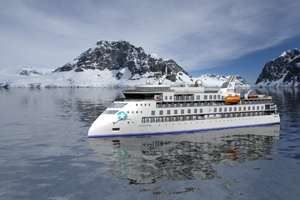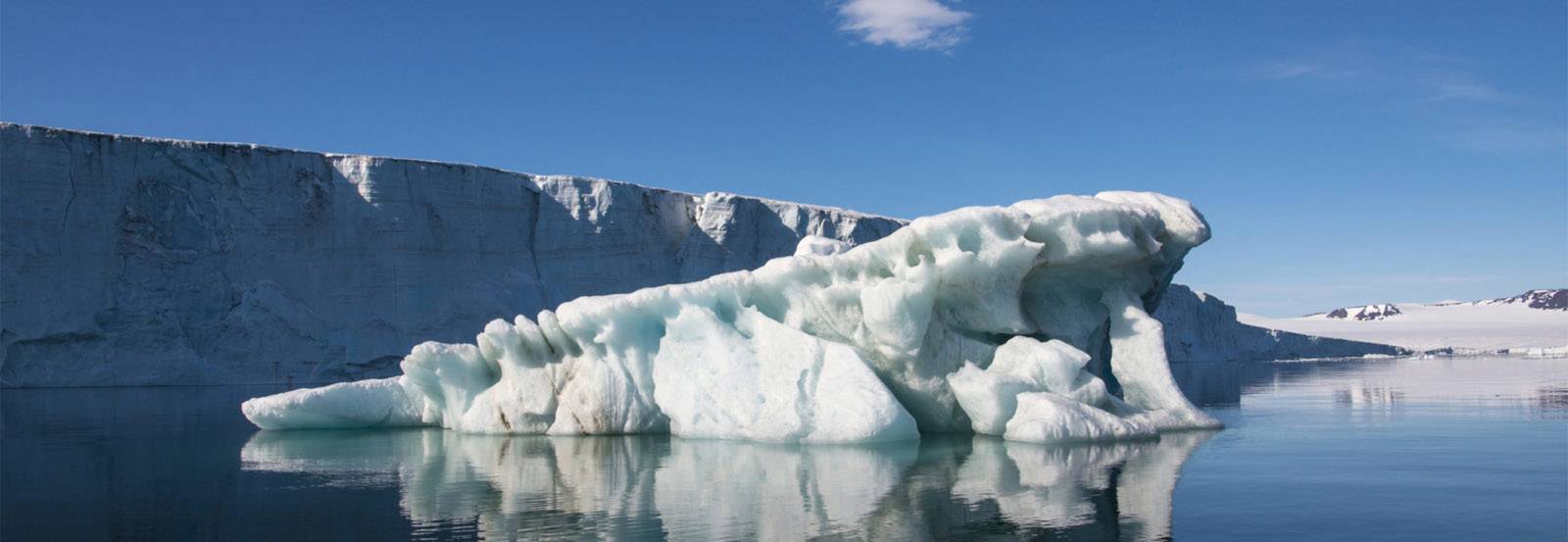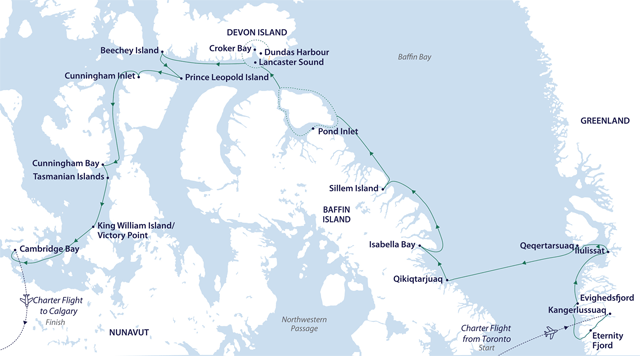HIGHLIGHTS
- Stand
in awe of Ilulissat Icefjord, a UNESCO World Heritage Site
- Hike
on Devon Island, the world’s largest uninhabited island,
which features stunning geology, fjords and glacial valleys to explore
- On
Beechey Island, visit memorials and graves of explorers from John
Franklin’s expedition
- Keep
watch with the hope of spotting iconic Arctic wildlife including musk
ox, polar bears, beluga whales, walrus and perhaps narwhal
DATES / RATES
Rates are listed per person in USD. Promotional offers are not reflected in the rates below.
|
| Start Date | End Date | Stateroom Triple | Stateroom Twin | Balcony Stateroom C | Balcony Stateroom B | Balcony Stateroom A | Superior Balcony Stateroom | Junior Suite | Captain's Suite |
|---|
Rates are listed per person in USD. Promotional offers are not reflected in the rates below.
|
| Start Date | End Date | (Starting from)
Stateroom Triple | (Mid-range)
Balcony Stateroom A | (High-end)
Captain's Suite |
|---|
ITINERARY
Day
1 Arrive Toronto
Having
made your way to Toronto Airport, check-in at Westin Toronto Airport
Hotel for an overnight stay. At our welcome briefing this evening,
enjoy a drink and meet fellow expeditioners. A representative from
Aurora Expeditions will provide you with important information about
biosecurity and also about the charter flight to Kangerlussuaq
tomorrow. You will receive Aurora Expeditions cabin tags for your
luggage. Please clearly label the tags with your name and ship cabin
number.
Accommodation:
Westin Toronto Airport Hotel (or similar)
Day
2 Embarkation, Kangerlussuaq
Please
ensure that your luggage is fitted with cabin tags clearly labelled
with your name and cabin number. Any valuables or personal items should
be kept on you throughout the day. Your luggage will be delivered to
your cabin ahead of your arrival on board.
After
breakfast at the hotel, board our charter flight to Kangerlussuaq,
Greenland, where our vessel Sylvia Earle awaits. After boarding, there
is time to settle into your cabin before our important safety
briefings. The sailling out of Søndre Strømfjord,
with its towering mountains on both sides, is magnificent. This
evening, meet your expedition team and crew at the Captain’s
Welcome Dinner.
Day
3 Sisimiut
Greenland’s
second largest town, Sisimiut is located approximately 54 kilometres
(33.5 miles) north of the Arctic Circle, meaning that during summer,
you can experience the midnight sun here. The town is famous for the
old blue church with the gate made of whale bone. In the cosy museum
next door to the church, you will find an excellent reconstruction of
an Inuit turf house as well as exhibits of local history and early life
in Greenland.. Sisimiut offers hiking trails with various degrees of
difficulty. The easier trails take you through the town itself, its
outskirts and into the mountains, where you will find spectacular
vantage points.
Approximately
4,500 years ago, the Saqqaq culture arrived from Canada and settled in
the area. They lived here for approximately 2,000 years, after which
they mysteriously disappeared from the area. The Dorset
culture arrived around 500 CE and stayed until the 1200s until they
were replaced by the Thule culture, and today, the majority of the
population of Sisimiut are descendants of the Thule culture.
Day
4 Ilulissat
Known
as the ‘birthplace of icebergs’, this region
produces some of the most dazzling icebergs found anywhere on earth.
Hike to the UNESCO World Heritage-listed Icefjord and stand in awe of
its immensity. Sermeq Kujalleq, also known as Jakobshavn Glacier, is
the most productive glacier – not only in Greenland but the
entire Northern Hemisphere. It produces 20 million tonnes of ice each
day, all floating into the Ilulissat Icefjord and Disko Bay. Conditions
permitting, enjoy a Zodiac cruise at the mouth of the fjord and kayak
through sea ice and icebergs. An optional 90-minute helicopter flight
over the icefjord is a truly once-in-a-lifetime experience.
Optional
helicopter flight (90 mins): this excursion is the only way you can get
close to the gigantic glacier. The 12-seater helicopter departs from
Ilulissat Airport and sweeps over hills, lakes and ice fjords. Land on
the mountain at Kangia, in the middle of the preserved area, where you
can revel in the incredible surroundings. On the return flight to
Ilulissat, fly above the edge of the glacier with breathtaking views of
the massive icebergs drifting in the fjord. The views of some of the
largest icebergs that become stranded on a moraine underneath the
water, just outside the town, offers a wonderful finale to this
excursion. (Additional charge applies). Please note this excursion
requires a minimum of 8 people to operate.
Day
5 Qeqertarsuaq (Disko Island)
This
compelling island seems to have more in common with Iceland than
Greenland. While most of the interior is mountainous and glaciated, its
beautiful shorelines boast black sandy beaches, unusual basalt columns,
hot springs and dramatic lava formations. On a guided hike, enjoy a
diversity of arctic flora. Zodiac cruise in Disko Bay, a hotspot for
marine life including humpback, fin, minke and bowhead whales.
Day
6 At sea, Qikiqtarjuaq, Baffin Island
Our
team of experts entertain us with informative talks about wildlife,
geology and epic tales of early explorers such as Franklin and
Amundsen. Reaching the coast of Baffin Island, we may encounter
Greenland’s famous icebergs. Keep watch for humpback, sei,
sperm and fin whales, as well as various species of seals such as ring
and harp seal.
Day
7 Isabella Bay
Farther
north along the east coast of Baffin Island we visit Isabella Bay, an
important summer and autumn feeding ground for a large population of
bowhead whales.
Day
8 Sillem Island
We
sail around Sillem Island, with glacial features on all sides. A slow
cruise offers the chance to see many glaciers as well as a variety of
seals and other arctic wildlife.
Day
9 Pond Inlet (Mittimatalik), Bylot Island
The
picturesque hamlet of Pond Inlet, overlooking Eclipse Sound, is
surrounded by scenic mountain ranges and numerous glaciers and fjords.
Travellers come to marvel at the abundant wildlife hoping to see
narwhals, beluga and orca whales, ringed and harp seals, caribou and
the occasional polar bear. Explore churches and visit the Natinnak
Center to see exhibits showcasing the culture and history of the local
Inuit people.
In
the afternoon, sail along coastline of nearby Bylot Island. Covered
with mountains, icefields, steep cliffs, snowfields and glaciers, Bylot
provides nesting habitat for large numbers of thick-billed murres and
black-legged kittiwakes. A total of 74 unique species of arctic bird
thrive on this island. Due to the richness of the wildlife and the
beauty and diversity of the landscapes in the area, a large portion of
the island was also included in the Sirmilik National Park, established
in 2001.
Day
10 Devon Island, Lancaster Sound
At
a latitude almost 75° degrees north, we are now truly in the
High Arctic. Here, nutrient-rich waters support an abundance of
wildlife, giving the area the moniker ‘wildlife super
highway’ of the Arctic. Devon Island is the largest
uninhabited island on earth and features stunning geology, with
flat-topped mountains and glacial valleys giving Devon Island its
unique character. We may explore Croker Bay or Maxwell Bay, both
offering great opportunities for Zodiac cruising. Dundas Harbour offers
walks on undulating tundra and the area is great for birdwatching. A
dilapidated Royal Canadian Mounted Police outpost and remnants of a
Hudson’s Bay Company trading post can be found here. In the
bay, walruses are often present.
Day
11 Beechey Island, Lancaster Sound
At
the western end of Devon Island lies Beechey Island. Named after
Frederick William Beechey, the island is one of Canada’s most
important arctic sites and is a designated Canadian National Historic
Site. During the Franklin expedition of 1845–46, Franklin
attempted to sail through the Northwest Passage with HMS Erebus and HMS
Terror, with perilous results – three of his men died here.
Roald Amundsen landed at Beechey Island in 1903, during the first
successful voyage by ship to fully transit the Northwest Passage from
the Atlantic Ocean to the Pacific Ocean.
Days
12–15 Expedition cruising
Note:
In true expeditionary style, our itinerary for the following days is
heavily dependent on unpredictable sea ice. The following places are
where we hope to visit.
Prince
Leopold Island
On
the southern side of Lancaster Sound from Beechey Island lie the
towering bird cliffs of Prince Leopold Island, a historic site where in
1848, English explorer James Clark Ross overwintered during the search
for the missing Franklin expedition. Prince Leopold Island is the most
important bird sanctuary in the Canadian Arctic, with approximately
500,000 birds nesting here in summer. Ringed seals are often spotted on
the sea ice around the island and polar bear often lurk nearby. The
shallow gravel beds attract beluga whales, who come to moult in this
part of the Arctic each summer.
Cunningham
Inlet
On
the north coast of Somerset Island, when factors such as weather and
whale behaviour align, you might see the amazing spectacle of hundreds
of beluga whales shedding their skin on shallow sandy banks. The local
scenery makes for excellent guided walks, where waterway trails lead to
waterfalls and higher ground.
Prince
Regent Inlet, Fort Ross
Sailing
down the east coast of Somerset Island, you might spot beluga whales
and narwhals as they feed on the large numbers of arctic char that
enter Creswell Bay in late summer. An important bird area, the bay also
attracts such species as black-bellied plovers, king eiders and
white-rumped sandpipers. At Fort Ross, see an abandoned
Hudson’s Bay Company trading outpost founded in 1937, which
closed in 1949 because supply ships could not get through the thick sea
ice. Enjoy guided walks on the tundra.
Bellot
Strait
A
deep and windy waterway bordered by steep slopes, Bellot Strait is
characterised by strong, swirling, tidal currents that require
navigation to be undertaken close to times of slack water (four times a
day). Point Zenith, the most northern continental point of the Americas
is located in the strait.
Note: Due to
swirling currents up to 10 knots, Bellot Strait is better transited
during eastbound voyages because if it is blocked, there is the
alternative to continue north through Peel Sound. On a westbound
voyage, it would be necessary to make a long detour back north through
Prince Regent Inlet.
Coningham
Bay
Across
from Victoria Strait, Coningham Bay lies on the shores of Prince of
Wales Island. This is a polar bear hotspot where the majestic creatures
come to feast on beluga whales often trapped in the rocky shallows at
the entrance to the bay. It is not unusual to find the shoreline
littered with whale skeletons – and very healthy-looking
polar bears!
King
William Island
In
1859, a Franklin expedition tent camp was discovered at Cape Felix.
Remains attributed to the Franklin expedition have been found at 35
locations on King William Island and on nearby Adelaide Peninsula.
South of Cape Felix, in Victoria Strait, we hope to visit Victory Point
and get close to where the HMS Erebus and HMS Terror were abandoned in
1848.
Day
16 Cambridge Bay
In
Cambridge Bay, farewell the crew, expedition team and fellow travellers
before a Zodiac shuttle whisks you ashore. Transfer to the airport for
a charter flight to Calgary, where you will stay overnight.
Accommodation:
Delta Calgary Airport Hotel (or similar)
Day
17 Depart Calgary
Check
out of your room and continue your journey.
Sylvia Earle (Luxury Expedition, 126-guests)
Due to sail in October 2021 our new ship honours the highly accomplished marine biologist, oceanographer and explorer, Sylvia Earle. As the first female chief scientist of the U.S. National Oceanic and Atmospheric Administration, and named by Time Magazine as its first Hero for the Planet in 1998 - this vessel pays tribute to Sylvia's long standing conservation efforts for marine protected areas and ocean wildlife. Sylvia Earle will be actively involved in the development of her namesake.
 (Click image to view Ship details)
(Click image to view Ship details)
WHAT'S INCLUDED
- All
transfers mentioned in the itinerary.
- Welcome
reception / pre-embarkation briefing on Day 1.
- One
night's hotel accommodation including breakfast, in Toronto on Day 1.
- One
night's hotel accommodation including breakfast, in Calgary on Day 16.
- Charter
flight from Toronto to Kangerlussuaq on Day 2.
- Charter
flight from Cambridge Bay to Calgary on Day 16.
- Departure
transfer from the pier to airport on Day 16.
- On-board
accommodation during voyage including daily cabin service.
- All
meals, snacks, tea and coffee during voyage.
- Beer,
house wine and soft drinks with dinner.
- Captain's
Welcome and Farewell receptions including four-course dinner, house
cocktails, house beer and wine, non-alcoholic beverages.
- All
shore excursions and Zodiac cruises.
- Educational
lectures and guiding services provided by Expedition Team.
- Complimentary
access to onboard expedition doctor and medical clinic (initial
consultation).
- One
3-in-1 waterproof polar expedition jacket.
- Complimentary
use of Muck Boots during the voyage.
- Comprehensive
pre-departure information.
- Port
surcharges, permits and landing fees.
Exclusions
- International
or domestic flights – unless specified in itinerary.
- Transfers
– unless specified in itinerary.
- Airport
arrival or departure taxes.
- Passport,
visa, reciprocity and vaccination fees and charges.
- Travel
insurance or emergency evacuation charges.
- Hotels
and meals – unless specified in the itinerary.
- Optional
excursions and optional activity surcharges.
- All
items of a personal nature, including but not limited to alcoholic
beverages and soft drinks (outside of dinner service), laundry
services, personal clothing, medical expenses, wi-fi, email or phone
charges.
ADVENTURE
OPTIONS
- Sea
Kayaking: USD 1,190 per person
- Photography:
FREE
- Bird
watching:
FREE
- Lectures
on wildlife, our environment, history and destinations:
FREE
- Trips
ashore:
FREE
- Walking:
FREE
- Whale
and mammal spotting:
FREE
- Zodiac
cruises:
FREE



